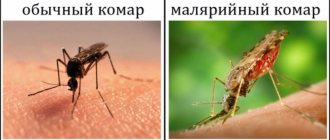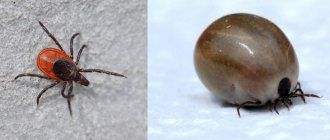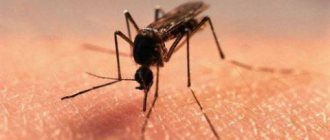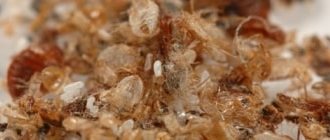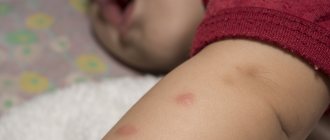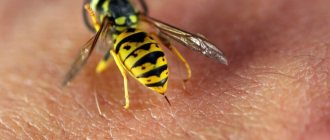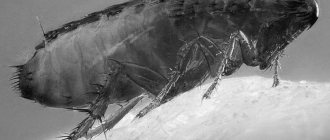It is important to know that bed bugs do not carry diseases, which cannot be said about other blood-sucking insects. Before you panic, study the distinctive features of blood-sucking insect bites. The difference in the bite will tell you who you need to save yourself from.
Count Dracula, the most famous of all bloodsuckers, and the vampire bat, as an example of the undead, belong more to myth. Real bloodsuckers are not so spectacular, they are very small, but they can make your life hell.
In the morning you found a red spot on your body, swollen and hot, which burns and itches?! Most likely it is an insect bite!!!
To find out, study photos of different bites, and we will comment and try to explain the subtle differences.
It is important to quickly begin targeted treatment depending on the type of bite, in order to quickly relieve the symptoms, but above all, to protect against possible serious secondary problems.
It doesn’t matter what instincts the insect was guided by: it was a bloodsucker or it was a bite in self-defense. Ultimately you suffer.
How are bedbug bites different from mosquito bites?
Mosquitoes are probably the biggest pests during the warmer months of the year. They bite us because they need blood protein for their eggs. Only females attack. They inject a protein that blocks blood clotting so they can feed on us fearlessly. Our body, however, is allergic to this protein.
What do mosquito bites look like? From a mosquito feast, blisters quickly form, ranging in size from 0.2 to 0.5 cm in bad cases and more. The spot itches a lot, but does not hurt. The middle often appears whitish with a red border. Blood is usually not visible.
To know if you were bitten by a mosquito and not a bedbug, compare these signs of a bite with the bedbug bites listed below.
Clue!
It is enough to see that the bites do not follow each other, but are randomly scattered throughout the body, to diagnose that this is a mosquito bite and not a bug bite.
What is the difference between a bug bite and a flea bite?
Fleas are the most adapted and independent compared to other bloodsuckers. Both the female and male animals bite their prey. Flea bites are similar in appearance to bedbug bites due to the intensely itchy punctures on the skin in a row. Within 24 hours, the bite can become the size of a pea, which is visible and will bother you for up to two weeks.
How can you tell who has moved in with you: bedbugs or fleas?
Flea bites: rarer, but with severe itching. Usually fleas also look for people at home. They can jump with their long legs up to 50 cm.
Since bedbugs are nocturnal animals, in the morning they surprise their owner with a whole armada of itchy spots, lovingly left in the knees, armpits, stomach and chest.
Clue!
If bites appear not only in the morning, but several times a day, then most likely your enemy is not a bug.
What is the difference between a bug bite and a midge bite?
Midges are an integral part of summer in Russia, and you can often see clouds of insects gathering on humid, warm days.
Although their bites are usually not serious and do not transmit disease, they can be irritating, causing swelling and painful itching. Some people may react poorly to midge bites, and these symptoms may be particularly intense or last longer than usual. If you are bitten by midges and the tooth does not go away after a few days, do not delay, consult a doctor.
Clue!
Midge bites are erratic and look more like mosquito bites than bedbug bites.
How to distinguish a tick bite from a mosquito bite
Mosquitoes are the epitome of night tormentors. After sunset comes the hour of this terrible bloodsucker. Zzzzzzzzzzzzz! Everyone knows this buzz. As soon as a person goes to bed, they come out of their hiding places and look for their victims in the bedroom.
Mosquitoes literally burrow into your skin. They take a minute or two to feed themselves. The human body reacts to its insidious attack by releasing the hormone histamine. This dilates the blood vessels so that fluid enters the tissue, which in turn causes swelling. Bites to the eyes are a special meanness of mosquitoes. Praying, swearing, or clapping your hands does not help against mosquitoes. The only thing that compensates for this is the chemistry club and mosquito net. Because mosquito repellent ointment and gel can cause skin irritation, they should be avoided as much as possible.
But if you come to the forest or garden, you will have to spray all exposed parts of your body and clothing with repellent. In addition to mosquitoes in nature, another enemy awaits you, much more dangerous. These are ticks. Their bites can transmit viruses that cause early summer meningoencephalitis (TBE). The symptoms are similar to the flu and can cause inflammation of the brain and meninges.
The most common tick-borne disease is tick-borne borreliosis (Lyme disease). It is caused by a spiral bacterium, Borrelia burgdorferi, which lives in the intestines of the tick. Anyone suffering from Lyme disease must undergo weeks of antibiotic treatment. A tick can also infect you with typhus, tularemia or ehrlichiosis.
Ticks prefer warm, moist areas of the body. They may migrate to your armpits, groin, or hair. When they get to the desired location, they burrow into your skin and begin sucking blood.
Clue!
Unlike most other insects, ticks usually remain attached to your body after they bite you. If you have a tick, you will most likely know for sure because you will find it on your skin. After a period of up to 10 days of bloody feast, the tick may become saturated and swollen several times, and may detach and fall.
How to distinguish a bug bite from acne
Bed bug bites resemble pimples and appear as small, red, itchy, and swollen spots that appear in clusters. They appear in the morning after you have been bitten at night. They look like pimples. But bed bug bites don't break out like some pimples. They also appear in different places, such as on the arms and legs, where you are much less likely to get pimples or pimples.
Whiteheads
Whiteheads are a type of pimple that can occur due to acne. This is a place with a small white and yellow dot in the center.
The rest of the spot is red and swollen. This point is an accumulation of pus caused by the presence of sebum, which is blocked by entering the pores. It contains a small amount of bacteria that creates an infection in the pore. The body begins to fight the infection, which leads to the formation of pus.
Clue!
Bed bug bites never have a white spot in the center.
Blackheads
Blackheads are a type of pimple in which dirt accumulates in the pores. Unlike whiteheads, the pores are not closed. Instead, you have an open spot with black in the center. This black spot is caused by oxidation of sebum. Eels are similar to each other. The only difference is that the pores are not blocked, so pressure cannot build up.
Clue! Bed bug bites do not have black spots in the center. Although they are red and swollen like pimples, they are smooth.
Where do acne and bed bug bites appear?
Another significant difference is that pimples appear in sensitive areas where there is a lot of sebum that accumulates in the pores.
These are the places where the body has sebaceous glands:
- Forehead
- Nose
- cheeks
- Chin and jaw
- Shoulders, chest and upper back
Clue!
Bedbug bites do not only appear in these places. You can get them anywhere there is open access to your skin. Although the head is exposed, bed bugs prefer the neck as your face moves too much and is too sensitive.
Bed bugs will also bite your arms and legs as they stick out from under the blanket. So if you have a lot of spots and marks here, it's more likely to be bed bugs than acne.
Reaction to an insect bite
- Ants Red ants are the worst of the worst. It’s not for nothing that they are called fiery, because their bite is equivalent to a fire burn. At the time of the bite, such an ant injects poison into the wound with a toxin that can cause a severe allergic reaction. Fortunately, this type of ant is not found in our latitudes, but it is worth knowing about the peculiarities of the bite of this exotic insect.
We are more familiar with the red ant, whose bite resembles a mosquito bite. It also causes itching, redness and discomfort. The bite of one insect is not dangerous, but multiple bites can provoke an allergic reaction.
- Fleas The cause of close contact between people and fleas is pets. Fleas are parasites that carry many diseases that are dangerous to humans. Flea bites can easily be confused with an allergic reaction or a mosquito bite. But if you are careful, you will notice that the flea leaves only one puncture at the site of the bite. The affected area swells, turns red and itches unbearably. Within a few days, the bite site may turn into a festering wound as the victim constantly scratches the affected area.
- Ticks A tick bite is not accompanied by pain. Having attached itself to the human body, the tick is able to remain unnoticed for a long time. A round redness appears at the site of the bite. General symptoms after a tick bite appear only after a few hours. Headache, chills occur, body temperature rises, weakness and photophobia appear. If the parasite is detected in a timely manner, you need to get rid of it as soon as possible. If a tick remains unnoticed for a long time, you should immediately consult a doctor. Remember, ticks are parasites that carry infections dangerous to humans! The most common of them is tick-borne encephalitis.
- Bees Bees do not tend to bite a person just like that, because the bite takes their life. However, no one is safe from an accidental bee sting. An insect attack is accompanied by sharp pain and burning. A tumor almost instantly appears at the site of the lesion, from which a bee’s sting protrudes.
The skin turns red and a rash may develop around the affected area. In extreme cases, an allergic reaction to insect venom may occur, which is accompanied by swelling of the respiratory tract, convulsions and can even lead to death of the victim.
- Hornets Hornets are true predators of the insect world; they are extremely dangerous to humans. When biting a person, the hornet is capable of inflicting several attacks in a row, while the sting remains with the insect. Unlike bees, hornets are not so wasteful with their venom, because they use it for hunting. The bite is accompanied by sharp pain, burning, redness and swelling. Bite areas in the face area swell the most. If medical care is not provided promptly, an allergic reaction can be fatal. A bite committed simultaneously by a large number of individuals is also dangerous to human life.
- Mosquitoes A mosquito bite is not at all difficult to recognize, because it is often accompanied by an obsessive buzzing insect. It seems that in the summer you simply cannot escape from small pests! A mosquito bite causes minor itching and quickly disappearing inflammation. Just try to control yourself and not scratch the affected areas.
- Spiders All spiders are poisonous to some extent, because poison is a weapon that helps them get food. So how can you tell a simple scratch from an arthropod bite? Most often the bite is painless, but sometimes a tingling sensation is felt. A white spot with reddened edges forms at the site of damage. After a few minutes, symptoms may increase, pain, cramps, and swelling occur. Sharp pain in the appendix area may indicate a karakurt bite. But, fortunately, in our latitudes there are no particularly dangerous species of arthropods.
- Bedbugs Bedbugs greatly poison the lives of many, disrupting sleep patterns, thereby reducing productivity. If after waking up you notice multiple bites on your body, most likely there are bedbugs in your house. The main difference is the massive, densely spaced bites. The bite mark usually remains for a long time, which distinguishes a bug bite from an allergic reaction.
As you can see, poisonous insect bites are a common occurrence even in our latitudes. So it’s worth thinking about safe outdoor recreation today!
Can a bedbug bite burst?
Bedbug bites become swollen compared to the skin around them and feel like they might burst. But this never happens.
Whiteheads can burst because the pores are clogged and the inflamed area swells. Pressure builds up inside until it bursts on its own or you squeeze out the pus yourself. After the pus drains, the inflammation gradually goes away.
Bed bug bites swell for another reason. They swell because the bedbug uses its saliva to numb you at the site of the bite. Your body recognizes this saliva as a dangerous foreign substance. What happens next is called a histamine reaction. The area around the bite becomes inflamed to increase blood flow and the number of antibacterial cells sent by the immune system.
If you try to squeeze a bed bug bite, it won't pop because there is no extra fluid underneath the surface of your skin, it's just layers of skin, fat and blood.
Prevention
Having discovered signs of bites on the body, you need to try to determine which insects caused their appearance. Photos depicting the characteristic symptoms of bites will help with this. Once it becomes clear that bed bugs are the cause of the damage, you must immediately take measures to completely exterminate them. There is no other way to avoid new bites.
How can you exterminate bedbugs in your home? There are two ways:
• Use the services of exterminators; • Treat the premises with aerosols yourself. The first option should be chosen if the room is heavily contaminated. Professionals use the most effective means to kill bedbugs, which are prohibited for use in everyday life. But if there is no opportunity to turn to professionals, or the contamination of the premises is minor, then you can deal with the problem yourself. To do this, you will need to purchase a chemical product (it is better to choose a specialized one, created specifically to combat bedbugs) and carry out the treatment in accordance with the instructions given in the instructions.
How long do pimples and bites last?
Pimples for several days. Whiteheads will continue to develop until they burst. And then the inflammation will go away for about a week.
Bed bug bites develop and disappear in different ways. The stain begins to form the morning after the bite. It will remain about the same size for a week and then disappear during the second week. This means that they form faster and disappear more slowly than pimples.
At the same time, you will likely continue to be bitten by bed bugs. So, while pimples may come and go, bed bug bites will continue to appear.
How do bedbugs bite?
First define:
- Which area of the body is affected (Under clothing or not, in what place near clothing.)
- Type and intensity of symptoms? (Bite size, redness, swelling, itching, pain, allergic reactions, shortness of breath?)
- Is it one bite or are there several or even many?
- Where did the attack take place? (outside or inside, summer or winter, day or night?)
Bedbug bites may initially be mistaken for bites from mosquitoes, midges, ticks or fleas. But in fact, they have a number of features that prevent them from being confused with other insect marks.
- Bed bugs love to make their own personal paths on the skin. Their traces are arranged in a certain order. Bed bug bites may form a line or appear in a zigzag pattern. They follow each other. As they are sometimes called: breakfast, lunch, afternoon snack, dinner.
- Bed bugs can bite anywhere on the body where there is skin. Typically in areas exposed during sleep, such as:
- neck
- face
- hands
- shoulders
- hands
- legs
Many people do not feel the bite itself or there are no obvious symptoms, except for the points where there was a small bite, as well as minor inflammation and irritation around it. People who are hypersensitive to stings will have more severe symptoms. In most cases, symptoms appear immediately after the bite, but they may develop or progress over the following days. Without further irritation, symptoms usually resolve within a week or so.
Almost all bed bug bites cause some degree of discomfort, usually itching and inflammation.
Other signs and symptoms of bedbug bites include:
- burning painful sensation
- raised, itchy bump with a distinct bite center
- red itchy bump with a dark center and a lighter swollen surrounding area
- small red bumps arranged in a zigzag or line pattern
- small red bumps surrounded by blisters
- papular rashes or areas of skin with raised or flat patches that may be inflamed
Confirmation that you have been bitten by a bedbug will be small blood stains from bites on sheets or bedding, reddish or reddish-brown dried spots on fabrics due to bedbug droppings, or white or transparent skins shed by nymphs as they mature.
Consequences
In principle, a bug bite in itself does not pose any particular health hazard. There is currently no evidence that these insects carry infections. However, the consequences can be quite serious: • Individual reactions of the body. In some people, allergic reactions to bedbugs can be severe, which is manifested by the formation of significant swelling, the appearance of a rash, runny nose and other symptoms.
• Possible infection. The results of the “night hunt” of bedbugs cause an itching sensation, which provokes scratching with damage to the skin, and scratches on the skin favor infection. In this case, a serious inflammatory reaction may develop, requiring long-term treatment.
• Psychological trauma. The awareness that insects crawl on your body at night drinking blood does not contribute to restful sleep.
How dangerous are bedbug bites?
As a rule, apart from itching and a constant desire to scratch the skin, bedbug bites do not pose any particular danger. Bed bugs, with the exception of tropical bedbugs, do not transmit diseases. However, for some particularly sensitive people they cause a lot of trouble.
The individual characteristics of the person who is bitten also influence health.
Some people develop serious reactions from bed bug bites.
Serious symptoms that require medical attention include:
- labored breathing
- fever
- feeling nauseous or flu
- swollen tongue
- arrhythmia
Living with bed bugs can cause additional health complications:
- Increased chance of infection: due to damage to the surface of the skin.
- Sleep deprivation: Waiting for bed bugs at night can be extremely stressful. Some people, out of fear, try to stay awake all night or get only superficial and restless sleep.
- Decreased health. Chronic sleep deprivation is associated with feelings of depression, anxiety, general fatigue and decreased immune function. Misconceptions about bed bugs, especially misconceptions of bed bugs and lack of cleanliness, can add to depression and low self-esteem.
First aid for allergic urticaria
The first step is to stop exposure to the allergen if possible. Next, if prescribed by a doctor, you must take an antihistamine (loratadine, fexofenadine, cetirizine). To reduce itching, you can use sunburn cream, and also change to cotton clothes.
Please note: On our portal you can read a detailed article about the symptoms, types and treatment of urticaria
If Quincke's edema develops, low blood pressure, nausea, vomiting, or loss of consciousness, you should immediately call an ambulance.
How to protect yourself from bites
There is no effective repellent for bed bugs, so avoidance is the best defense. If there are already bedbugs in your bed, start a mortal battle with them. In the meantime, the outcome of the battle is not yet decided, you can use odors to prevent bedbug bites.
You can protect yourself from bloodsucker bites by applying clove or lavender essential oil diluted with either coconut oil or olive oil to your skin, focusing on your arms, legs, and neck. Although there is no guarantee that essential oil will provide you with 100 percent protection from bedbugs and their bites, it will still be some kind of attempt to repel them.
Treatment of allergic urticaria
Photo: Rash in the form of insect bites on a man's hand
The action of the allergen that caused the reaction ceases. In addition, the patient should switch to an elimination diet that excludes foods with a large number of allergens (chicken, citrus fruits, nuts, eggs, strawberries, spices, foods with a high content of dyes).
In acute cases of urticaria, antihistamines are prescribed.
In the case of the development of a severe form of the disease, infusion antihistamines, corticosteroids (prednisolone, dexamethasone), calcium preparations that reduce sensitivity to allergens (calcium chloride or gluconate) are used; when the allergen is taken orally, gastric lavage is performed, and activated carbon and other sorbents are also used.
For urticaria, the use of codeine, aspirin, including its derivatives, and ACE inhibitors is prohibited.
Treatment of bedbug bites
After you are bitten by a bed bug, your skin becomes red and sometimes itchy. In the worst case, it even leads to an allergic reaction.
Itchy areas can be treated with cooling and histamine-inhibiting ointments and gels. For example, aloe vera gel is useful.
Cooling can quickly relieve discomfort after bedbug bites. If there are a lot of bites, then it is good to cover the entire painful area with cold compresses or ice packs.
You can put half an onion on the bite. Doesn't help everyone.
For very severe itching, there are appropriate medications called antihistamines.
Some people are allergic to insect stings. In the worst case, this can lead to life-threatening allergic shock. If you experience symptoms of rapid breathing, fever, or dizziness after being bitten, seek immediate medical attention.
Causes of a mosquito-like rash
When pimples appear, mosquito bites make you itch, which is not always possible to understand. To do this, you need to compare the rash with the usual mosquito and identify inconsistencies.
The problem may lie in:
- Damage to tissues by various blood-sucking insects.
- Allergic reaction to food.
- Prickly heat.
- Infectious pathologies.
- Allergic urticaria.
- Vascular diseases.
- Development of meningococcal sepsis.
Nutritional atopy
Sometimes food allergies resemble mosquito bites. It can occur with any product and in severe situations can even lead to anaphylactic shock.
A distinctive feature of atopy is that pimples appear even under thick clothing and can merge. A food allergy on the skin like the mosquito bites in the photo can subsequently change color, shape, and size. Atopy appears suddenly after ingesting an allergen. If you take an antihistamine, the symptoms decrease. Patients also complain of nausea, vomiting, abdominal pain, and sometimes an increase in temperature.
Prickly heat
Spots on the body similar to mosquito bites may appear due to non-compliance with the thermal regime. Miliaria is more common in infants and is observed in the form of a small rash on the neck, forehead, back, and chest. In severe cases, blisters and purulent rashes form. In this case, the pimples look like mosquito bites.
A distinctive feature is the increase in temperature.
Infectious pathologies
When acne appears, like the skin itches after a mosquito bite, the reason may lie in a number of infectious pathologies:
- Measles. When the virus enters the body, catarrhal manifestations and rashes are observed throughout the body. Subsequently, the spots turn brown. During the incubation period, the temperature may rise significantly.
- Chickenpox. Most often diagnosed in childhood. The rash appears gradually and resembles blisters. There is a clear liquid inside the pimple; if it bursts, it will leave a scar for life. Usually the pathology is mild, but may be accompanied by fever, weakness, and conjunctivitis.
- Rubella. Red rashes have a bump in the middle. The disease progresses with catarrhal symptoms: rhinitis, conjunctivitis, redness of the throat.
- Scarlet fever. The disease occurs with fever, sore throat, and red rashes.
- Molluscum contagiosum. The rash looks like small bumps with a white center inside. They can stay on the skin for a long time without causing any discomfort and are able to go away on their own.
- Roseola. It is characterized by an increase in temperature and the appearance of a pink, raised rash. Papules usually do not bother you and go away on their own in 3-4 days.
Allergic urticaria
It occurs against the background of an allergic reaction to household chemicals, dust, pet hair, and clothing. The rash resembles pink blisters, similar to burns. The patient feels weakness, itching, burning.
Diseases of the blood and blood vessels
Pimples appear in the problem area as if caused by a mosquito bite. In addition, small bluish areas resembling bruises form nearby. Typically, a rash appears when tissue is injured.
Meningococcal sepsis
The patient is concerned about hyperemia and rashes. Symptoms increase rapidly, so immediate medical attention is required. Usually papules are localized on the legs. Over time, they transform into purple subcutaneous spots.
